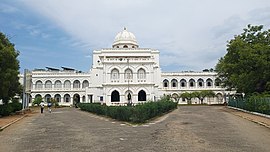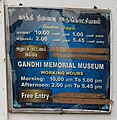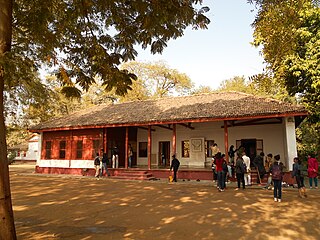
Sabarmati Ashram is located in the Sabarmati suburb of Ahmedabad, Gujarat, adjoining the Ashram Road, on the banks of the River Sabarmati, 4 miles (6.4 km) from the town hall. This was one of the many residences of Mahatma Gandhi who lived at Sabarmati (Gujarat) and Sevagram when he was not travelling across India or in prison. He lived in Sabarmati or Wardha for a total of twelve years with his wife Kasturba Gandhi and followers, including Vinoba Bhave. The Bhagavad Gita was recited here daily as part of the Ashram schedule.

Sevagram is a town in the state of Maharashtra, India. It was the place of Mahatma Gandhi's ashram and his residence from 1936 to his death in 1948. After Sabarmati, Sevagram Ashram holds immense importance due to the residence of Mahatma Gandhi.
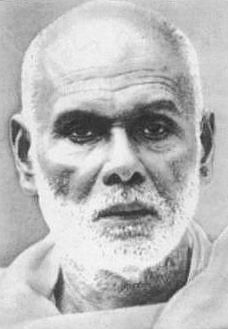
The Temple Entry Proclamation was issued by Maharaja Chithira Thirunal Balarama Varma on November 12, 1936. The Proclamation abolished the ban on the backward and marginalised communities, from entering Hindu temples in the Princely State of Travancore, now part of Kerala, India.

The Aga Khan Palace was built by Sultan Muhammed Shah Aga Khan III in the city of Pune, India.

Sardar is a 1993 Indian biographical drama film on Sardar Vallabhbhai Patel, one of India's greatest freedom fighters, directed by Ketan Mehta and written by noted playwright Vijay Tendulkar. The film was screened retrospective on 12 August 2016 at the Independence Day Film Festival jointly presented by the Indian Directorate of Film Festivals and Ministry of Defence, commemorating 70th Indian Independence Day.
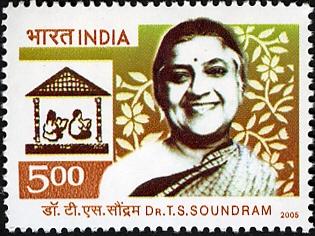
T. S. Soundaram Ramachandran was an Indian physician, social reformer and politician was the daughter of T. V. Sundaram Iyengar, the founder of T V Sundaram Iyengar and Sons Limited, popularly known as TVS Group of companies, one of India's largest industrial conglomerates. She was married young barely at the age of 14 in 1918, her husband Dr. Soundararajan, encouraged her to study. But when he died when she was in her teens, it was her parents who urged her to continue with her studies. It was at Lady Hardinge Medical College in Delhi that she did her medicine degree.
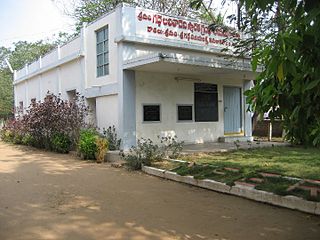
Gudavalli is a village in Guntur district of the Indian state of Andhra Pradesh. It is the located in Cherukupalle mandal of Tenali revenue division.
Maurice Frydman, aka Swami Bharatananda, was an engineer and humanitarian who spent the later part of his life in India. He lived at the ashram of Mahatma Gandhi and took an active part in India's fight for independence—notably in helping to draft a new constitution for the State of Aundh that became the Aundh Experiment. He was a Polish Jew who subsequently converted to Hinduism.
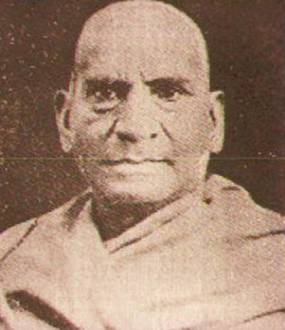
Swami Shraddhanand, also known as Mahatma Munshi Ram Vij, was an Arya Samaj sannyasi and an Indian Independence activist who propagated the teachings of Dayananda Saraswati. This included the establishment of educational institutions, like the Gurukul Kangri University, and played a key role on the Sangathan and the Shuddhi (purification), a Hindu reform movement in the 1920s.

Mahatma Gandhi Museum was formerly Alfred High School in Rajkot was one of the oldest educational institutions in India which was active for 164 years where Mahatma Gandhi studied few years.

The National Gandhi Museum or Gandhi Memorial Museum is a museum located in New Delhi, India showcasing the life and principles of Mahatma Gandhi. The museum first opened in Mumbai, shortly after Gandhi was assassinated in 1948. The museum relocated several times before moving to Raj Ghat, New Delhi in 1961.
Yerawada is a neighbourhood of the city of Pune in the state of Maharashtra, India. Before that British Raj Yerawada was known as Yeraoda. Yerawada is one of the most densely populated areas in Pune. It is located at the beginning of Ahmednagar highway and also on the way to old Pune Airport at Lohagaon. This place can be reached after crossing Mula-Mutha River through Yerawada Bridge from Bund Garden.
Dinanath Gopal Tendulkar (1909–1972) was an Indian writer and documentary film maker. He is most well known as the author of an eight-volume biography of Mahatma Gandhi, titled Mahatma: Life of Mohandas Karamchand Gandhi. He was also a close associate of Vithalbhai Jhaveri and collaborated for the documentary film, Mahatma: Life of Gandhi, 1869–1948. He died on Monday, June 12, 1972.
Brij Krishna Chandiwala was an Indian freedom fighter from Delhi and a political associate of Mahatma Gandhi who was awarded the Padma Shri in 1963 for his contributions to the field of social work.

The online Gandhi Heritage Portal preserves, protects, and disseminates original writings of Mohandas K. Gandhi and makes available to the world the large corpus of “Fundamental Works” which are useful for any comprehensive study of the life and thought of Gandhiji. Gandhiji was 24 years old in South Africa "Natal Indian Congress " made in 1894.
Harijan Sevak Sangh is a non-profit organisation founded by Mahatma Gandhi in 1932 to eradicate untouchability in India, working for Harijan or Dalit people and upliftment of Depressed Class of India. It is headquartered at Kingsway Camp in Delhi, with branches in 26 states across India.

The Gandhi Smarak Sangrahalaya is a museum and public service institution, showcasing the life and principles of Mahatma Gandhi, and his role in Bihar during the independence struggle of India. It is one of the eleven Gandhi Sanghralayas in the country.

Prabhudayal Vidyarthi, also known as, Prabhu Dayal Vidyarthi, was an Indian Freedom Fighter, Indian independence activist, Gandhian, Writer, Social Worker and politician. He heard Thakkar Bapa's public address, spreading Mahatma Gandhi's quest for "FREE INDIA", left home in search of Azaadi, aged barely 9/10 years, and became a close aide of Mahatma Gandhi. He followed Thakkar Bapa from Uska, in siddharthnagar district, Uttar Pradesh to Sevagram to meet Mahatma Gandhi and fight for India achieve Freedom from the British. Gandhiji, was perplexed to see such a young boy wanting to participate in “Indian Freedom Struggle” and allowed him to stay at 'Segaon', which later come to be known as Sevagram. He is listed as the youngest member of Wardha Aahram. Gandhi also personally taught him.
V. Kalyanam was an Indian freedom fighter and was Mahatma Gandhi's personal secretary during the last few years of Gandhi's life (1943–48). He joined the freedom struggle during Quit India Movement in 1942, and then worked with Gandhi till Gandhi's assassination. Kalyanam was just behind Gandhi when Nathuram Godse fired the shots. According to Kalyanam, Gandhi died instantly after being shot and never uttered "Hey Ram" as his last words. He was the first to inform Nehru and Patel about Gandhi's death.
